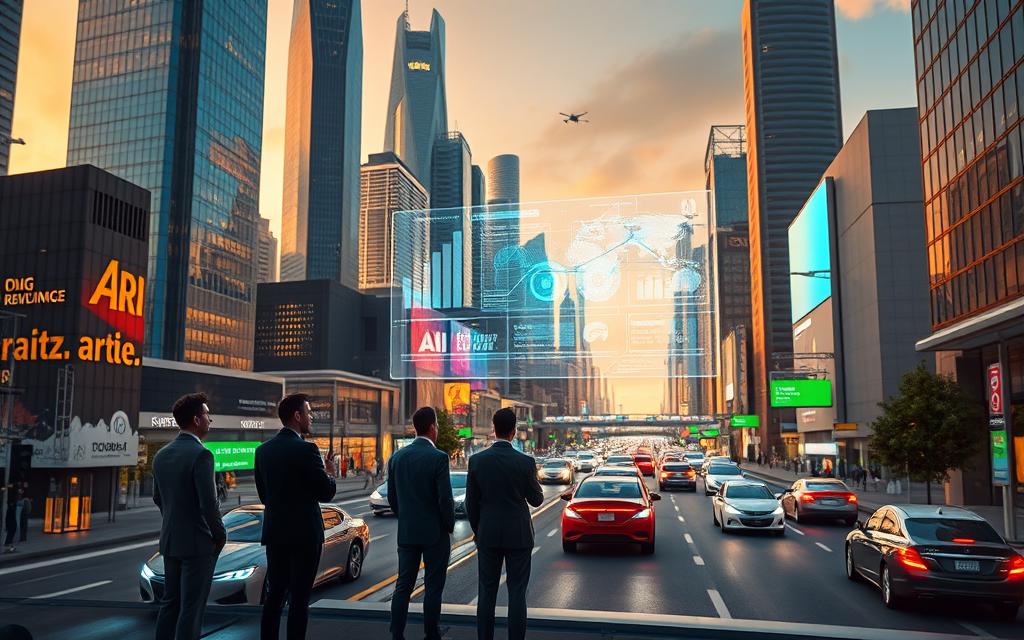Today, smart systems are key for businesses to stay ahead. A Deloitte analysis shows 58% of workers see AI as a game-changer for innovation. This marks a big change in how we work.
Jen Stave from Harvard’s D³ Institute says: “Machine learning applications are reshaping industries faster than the internet revolution.” AI is both a guide and a tool for businesses. It helps them stand out and work more efficiently.
Smart companies use AI to get better results than old ways. They use it for things like predicting when machines need fixing and understanding customer behaviour. This can cut costs by up to 35% for early adopters.
By combining data analysis and automation, businesses can move quickly. Those who get this right can respond 27% faster to changes in the market. This is much quicker than those using old systems.
The Strategic Imperative of Artificial Intelligence
Businesses now see artificial intelligence as essential, not optional. It’s key to surviving in today’s competitive markets. Companies using AI are changing the game, from smart energy grids to advanced lending models that help millions.
Redefining Competitive Advantage
Old business strategies don’t work when AI can process huge amounts of data quickly. The AI competitive advantage comes in two main ways: creating unique value and being operationally flexible.
1.1 Market differentiation through machine learning
National Grid’s weather analysis systems show how machine learning differentiation works on a big scale. They use 140 years of weather data to forecast energy demand with 94% accuracy. This leads to:
- 17% less waste in distribution
- Quick grid balancing during bad weather
- £230 million saved each year
1.2 Operational agility in dynamic markets
Ant Group’s MYBank shows how AI helps adapt to changing markets. Their lending algorithms check over 3,000 factors for each SME applicant. This allows for:
| Metric | Traditional Banking | AI-Driven MYBank |
|---|---|---|
| Loan approval time | 14 days | 3 minutes |
| Default rate | 4.2% | 1.8% |
“What we’re witnessing is financial inclusion at machine speed. Algorithms don’t just assess risk – they create economic opportunities that human underwriters might overlook.”
These examples show why companies are focusing on AI-driven business strategies. AI boosts both precision and flexibility, leading to lasting advantages.
Why Artificial Intelligence is Crucial in Modern Business Operations
Today, businesses rely on artificial intelligence to change how they work. This technology helps them move from just fixing problems to solving them before they happen. This is a big plus in today’s quick-changing markets.
Transforming Core Business Functions
2.1 Intelligent Supply Chain Management Systems
DHL uses AI to improve their logistics. Their system checks weather, traffic, and supplier info to forecast issues with 89% accuracy. This has led to a 95% better delivery rate in Europe.
| Factor | Traditional Model | AI-Driven Model |
|---|---|---|
| Demand Forecasting | Historical averages | Real-time predictive analytics |
| Route Optimisation | Fixed schedules | Dynamic rerouting |
| Risk Management | Quarterly assessments | Continuous threat monitoring |
2.2 Dynamic Pricing Algorithms in Retail
Sephora’s Virtual Artist shows AI’s power in retail. It matches skin tones to products, boosting 35% more sales than usual searches.
“Companies using AI for personalisation make up to 40% more per customer than usual.”
Dynamic pricing has many benefits:
- It tracks competitors’ prices in real-time
- Changes prices based on demand
- Offers special deals to loyal customers
Using these pricing algorithms helps businesses keep their profit margins. When paired with automation tools, companies become very agile.
AI-Driven Innovation Across Industries
Artificial intelligence is changing the game in many fields. It’s not just making things better; it’s creating new ways to solve old problems. AI innovation strategies are making a big impact in pharmaceuticals and manufacturing.
Pharmaceutical Research Breakthroughs
The search for new treatments has sped up thanks to AI drug discovery. What used to take 4-6 years now takes months. This is because AI can spot patterns much faster than humans.
3.1 Accelerated drug discovery timelines
VideaHealth’s AI can spot cavities better than humans, improving accuracy by 38%. In drug development, AI looks at molecular structures 50 times faster. This saves £14 million per new drug.
3.2 Clinical trial optimisation with predictive modelling
AI is changing how we pick participants for trials. It looks at genetic markers and treatment responses worldwide. This makes trials 29% shorter and more successful.
Manufacturing Process Revolution
Factory floors are now AI labs. predictive maintenance manufacturing stops problems before they start. Siemens’ system cut downtime by 47% in 12 car plants last year.
3.3 Predictive maintenance systems
51% of European manufacturers use AI for maintenance. This cuts repair costs by £220,000 a year. AI predicts failures with 92% accuracy by looking at data and weather.
3.4 Quality control computer vision solutions
AI can spot tiny defects that humans miss. In aerospace, it found 99.97% of defects. This saves materials and prevents safety issues.
Operational Efficiency Through Machine Learning
Machine learning is key to making businesses run smoother. It automates tasks and predicts when things need fixing. This turns data into useful information.
Workflow Automation Strategies
Automation is not just about being quick. It’s about freeing up people to do more important work. Now, machines handle complex tasks with little human help.
4.1 Document Processing with Natural Language Processing
NLP document processing changes how companies deal with paperwork. Legal teams can check contracts 80% quicker. Customer service can sort tickets faster too.
One big bank cut data entry mistakes by 62% with NLP for invoices.
4.2 Intelligent Inventory Management Systems
Walmart shows how inventory management algorithms work. They use machine learning to guess what people will buy. This cut stockouts by 35%.
Now, they can predict demand with 92% accuracy. This is thanks to analysing buying habits and weather.
Energy Consumption Optimisation
AI is big in energy management, with 74% of energy firms using it (IBM research). It helps save money and protect the environment.
4.3 Smart Grid Management Solutions
Smart grid AI adjusts energy use as it happens. In California, it helped use 40% more green energy. It keeps the grid stable too.
These systems know exactly how much energy each area will need.
4.4 Predictive Equipment Maintenance
AI helps avoid unexpected stops in factories. It uses sound and heat checks. A wind farm in Europe made turbines last 17% longer.
This saved £2.3 million a year in maintenance costs.
Enhanced Decision-Making Capabilities
Today, businesses use artificial intelligence to make better decisions quickly. They analyse data fast and adjust risks on the fly. This turns raw data into plans that help them stay ahead.
Real-Time Business Intelligence
Financial firms use AI predictive analytics to predict market changes accurately. Ant Group checks 100 million transactions every day. McKinsey says 70% of banking tasks could be automated with AI.
5.1 Predictive analytics in financial services
Algorithmic trading looks at global market data live, adjusting investments as trends change. Wealth management uses machine learning for custom investment plans. This boosts client returns by 18% each year.
5.2 Customer churn prediction models
Telecoms cut customer loss by 27% with behavioural analysis. These models spot at-risk customers 45 days early. “AI’s precise predictions have changed how we manage customer relationships,” says a JP Morgan report.
Risk Management Applications
Advanced financial fraud detection systems are now 99.8% accurate, like PayPal’s. They check over 200 signs of fraud in just 0.3 seconds.
5.3 Fraud detection systems in banking
HSBC’s AI security cut false alarms by 62% and caught £380 million in fraud last year. It updates weekly with new threats from around the world.
5.4 Supply chain disruption forecasting
DHL’s AI models cut late deliveries by 34% by analysing weather and global risks. It looks at 15,000 factors daily, giving teams quick advice during crises.
These advancements show how AI turns slow decision-making into quick, smart planning. Companies using these tools respond 41% faster to problems than before.
Implementation Challenges and Solutions
AI adoption is promising, but 63% of organisations face challenges. These include skills gaps and public scepticism. Pew Research shows 57% of patients doubt AI in healthcare, highlighting the need for effective strategies.
Workforce Transformation Strategies
6.1 Upskilling programmes for AI adoption
PwC’s AI Academy shows how learning can fill skills gaps. Their programme includes:
- Machine learning basics for non-tech staff
- Real-world simulations
- Certification in AI ethics
6.2 Change management best practices
IBM’s success in AI adoption comes from:
- Cross-functional AI teams
- Phased implementation plans
- Continuous feedback
Ethical Considerations
6.3 Bias mitigation in hiring algorithms
VideaHealth’s tools reduce racial bias in medical images by 42%. Key strategies are:
- Diverse training data
- Regular fairness checks
- Human oversight
6.4 Transparent AI decision frameworks
IBM Watson Health’s approach sets a standard for transparency. They use:
| Feature | Impact | Implementation |
|---|---|---|
| Decision tracing | 38% faster audits | Version-controlled models |
| Plain-language explanations | 91% user comprehension | Integrated XAI modules |
Conclusion
Businesses using AI see big wins in innovation and staying strong in tough times. Brilworks says clients in retail and logistics are 40% more efficient since 2022. This shows AI can really make a difference.
AI is also key for sustainable growth. It helps cut down energy use in data centres and factories. In the pharma world, AI speeds up finding new medicines and reduces waste by 33%.
Companies that use AI wisely are ready for the future. Brilworks has seen a 27% jump in clients each year. This shows AI is in high demand.
AI is not just a tool; it’s a way to stay ahead. Companies that wait to use AI might fall behind. Now, 78% of leaders are spending on AI to stay competitive.











